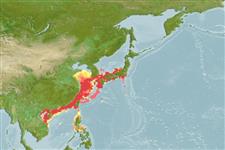Environment: milieu / climate zone / depth range / distribution range
Ecology
Marine; brackish; benthopelagic; oceanodromous (Ref. 51243); depth range 0 - 120 m (Ref. 43239). Temperate; 38°N - 13°N, 106°E - 141°E
Northwest Pacific: from central Vietnam to South Korea and Japan, Yellow and East China seas.
Length at first maturity / Size / Weight / Age
Maturity: Lm ?, range 17 - ? cm
Max length : 80.0 cm TL male/unsexed; (Ref. 4537); max. published weight: 243.60 g (Ref. 124479); max. reported age: 6 years (Ref. 104735)
Inhabit coastal waters and estuaries (Ref. 2113). Found in muddy or muddy-sandy bottoms shallower than 120 m depth (Ref. 43239). Feed on crustaceans and fishes.
Life cycle and mating behavior
Maturity | Reproduction | Spawning | Eggs | Fecundity | Larvae
Masuda, H., K. Amaoka, C. Araga, T. Uyeno and T. Yoshino, 1984. The fishes of the Japanese Archipelago. Vol. 1. Tokai University Press, Tokyo, Japan. 437 p. (text). (Ref. 559)
IUCN Red List Status (Ref. 130435)
Threat to humans
Harmless
Human uses
Fisheries: highly commercial; aquaculture: commercial; aquarium: commercial
Tools
Can't connect to MySQL database fbquizv2. Errorcode: Too many connections
